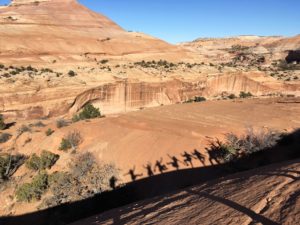 As my watch alarm wakes me from my intermittent slumber, I slowly lift my head from my sleeping bag to confront the cold morning air. It is now early November, almost two months into my semester with the Wild Rockies Field Institute, and the canyon country is being greeted with the first signs of winter. My fellow classmates and I have become rather accustomed to waking up to frozen toes, icy water bottles, and the occasional snow patch in the deepest shadows of the sandstone cliffs. Although this has made some nights more difficult than others, we still have the stars to keep us humble as we lay our weary heads to rest each night.
As my watch alarm wakes me from my intermittent slumber, I slowly lift my head from my sleeping bag to confront the cold morning air. It is now early November, almost two months into my semester with the Wild Rockies Field Institute, and the canyon country is being greeted with the first signs of winter. My fellow classmates and I have become rather accustomed to waking up to frozen toes, icy water bottles, and the occasional snow patch in the deepest shadows of the sandstone cliffs. Although this has made some nights more difficult than others, we still have the stars to keep us humble as we lay our weary heads to rest each night.
Each morning, as the sun graces us with his comforting presence, I gradually prepare myself for another day of curiously wandering through the sandy washes and smooth slickrock that make up Horseshoe Canyon. Some days, if we are lucky, we will see spotted burros, dinosaur tracks, or, on a heavier note, the soon-to-be-dinner of a fresh mountain lion kill. Despite these relics of mystery that lie around every corner, my body and mind have grown rather tired from the constant sensory stimulus of this two-month academic course. To help me get through some of the more difficult days, I have been trying to shift my focus towards more small, approachable wins, rather than the whole picture at once. This is a concept that has been introduced to me by Karl E. Weick, which argues that the quality of one’s performance increases when arousal on a perceivably large matter is reduced. Thankfully, I am also kept afloat by the seven other curious minds that I have grown to know over the past seven weeks. I find it difficult to believe that they were once strangers to me, for I know them now on a level that I do not know many others. In fact, it saddens me to imagine my life without them.
As we take our final steps through this landscape, we are repeatedly exposed to the small, intricate realms of beauty that live far beyond that which our eyes can see. To help us understand these indescribable experiences to a greater degree, we have been rehearsing the art of observation – a practice that is fueled by curiosity and wonder. In Kathleen Dean Moore’s article, The Truth of the Barnacles: Rachel Carson and the Moral Significance of Wonder, she writes that “a sense of wonder is an attitude of openness or receptivity that leads a person from a preoccupation with self into a search for meaning beyond oneself” (Moore 269). For me, this has come in many forms over the past seven weeks: the vast blanket of stars in the night sky; the towering walls of sandstone that have been carved by their intimate relationship with wind, water, and time; and the sweeping cities of cryptobiotic crust that glue this entire region together. It is through this sense of wonder that I am constantly reminded of why I fell in love with this land of slickrock and juniper in the first place, for this is where I felt my first memorable sense of awe as a child, and where I continue to feel that same sense of awe as an adult.
Now, as I transition away from this journey and into my new home in Jackson Hole, Wyoming, I hope to take with me the sense of wonder that I feel when my feet are planted in the desert sand. With the lessons of activism, hope, wonder, and awe in mind – all of which are themes we have been exploring throughout this section – I feel better equipped to stand up to the shadows of greed, dominion, and perpetual growth that currently exist in the society that I participate in. As author David W. Orr explains it, “hope is a verb with its sleeves rolled up.” With this in mind, the next time I feel crippled by the weight of the changing climate or the raging wildfires that threaten the places that I call home, I will use wonder and my intimate love for the land to confront the systems that perpetuate these acts of harm. All the while, I must always remember to ask for consent from Mother Earth, for I am here all thanks to her, and will continue to exist so long as she does.